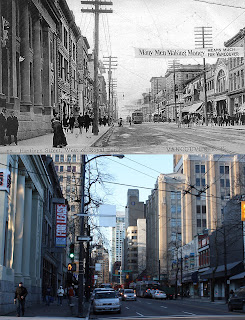First off, I just want to state that the purpose of this blog is not to research histories of the old buildings in the photos, but rather piece together what is left and add in some additional old photos of buildings, and as many then and now comparisons of the buildings I have done. While researching additional photos to use, I've come across many that will make splendid candidates for future then and now photos, so please, always check my
flickr site for newer additions. It's an ongoing project for me and I always come across old photos that are new to me.
This is one of my favourite blocks in the east part of downtown Vancouver. It features an intact streetscape of buildings with the newest building built in 1936 and the oldest dating back to 1889. Most have had only minor renovations done over the years, which is pretty admirable.
Okay, let's just jump right into the action. I have done three comparisons of this block, two from the 1900s and the third from the 1970s:
This was originally taken looking west up West Hastings Street from Homer Street, sometime in the 1900s, probably close to 1910 when Vancouver was booming, hence the banner:
 (CVA 677-616, Phillip Timms)
(CVA 677-616, Phillip Timms)This was taken around the same time as the photo above. Note the horse drawn carts and the very old school policeman in the photo, as well as a streetcar:
 (CVA 677-621, Phillip Timms)
(CVA 677-621, Phillip Timms)This was taken in 1974 and as you can see, most of the buildings are still there and feature many of their original detailing:
 (CVA 780-22, Public Records Photo)
(CVA 780-22, Public Records Photo)Now, let's get into some details about each building. Here's a handy reference picture which will make it easier to follow along:

Building#1: Royal Bank of Canada, 400 West Hastings Street.
This building was built in 1903 and served as Vancouver's Royal Bank headquarters from 1903 to 1931, and remained a local branch until 1981. It currently houses the Vancouver Film School (VFS).

This is what the building looked like in 1903, probably shortly after it was completed.
(VA Bu P78)
The view from the alley shows most of the rear windows have been filled in.

Some of the detailing on the front of the building.

 Building #2:
Building #2: Second Rogers Block, 412 West Hastings Street.
This building was built in 1898 and has been recently restored and is looking great.
 Building #3:
Building #3: Bank of Nova Scotia, 426 West Hastings Street.
Also built in 1903.

Here it is shortly after it was built. You can see how the top part has changed since it was built.
(VPL 5197, Phillip Timms) Buildings #4 &5:
Buildings #4 &5: Canadian Pacific Telegraph Building (left), 432 and 440 West Hastings Street.
The building on the left was built in 1900 and the newer building on the right is from 1936, which I found surprising! These buildings were actually consolidated as one, when the building on the right was built.

Here is evidence to that fact, from the alley. The brick building is the 1936 building but was built to wrap around the old building. The age of the addition and infill building is revealed a little better with those great old windows.

On the right is the building that was there previous and was the last building on the block to be demolished.
The Bank of Nova Scotia, as it looks today, is on the left and telegraph building is in middle. This photo is from 1918.
(VPL 20441A Dominion Photo Co) Building #6:
Building #6: 450 West Hastings Street.
Built 1901 and currently houses Sophia Books.
 Building #7:
Building #7: Bank of British Columbia, 422 Richards Street.
This fabulous old-timer was built in 1889 and was one of the first commercial buildings to be built outside of Gastown. Sadly, some of its ornamentation is gone but perhaps one day it will be restored. A few photos down reveals what the building used to look like.
Building #9: Standard Building, 510 West Hastings Street.
This large heritage building was built in 1914 and is one of my favourite buildings in the city. It's such an impressive old building. It sits on the next block over from the 400 block but I thought I would include it as it's part of the then and now views at the top.

This photo is from 1921 and you can see the Bank of BC building on the left.
(VPL 10740 Leonard Frank)
A few additional historic photos:
This is West Hastings Street in 1936 during a Jubilee parade. You can see the 400 block on the left side.
(VPL 19347 Phillip Timms)
And here's a view down the street from 1938 with the Standard Building in the background.
(VPL 5853 Leonard Frank)



































